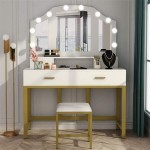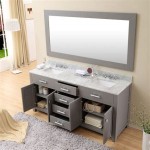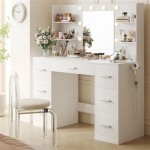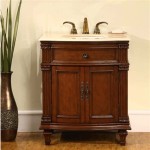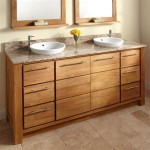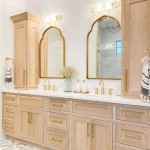Solid Wood 24 Inch Bathroom Vanity: A Comprehensive Guide
The 24-inch bathroom vanity is a popular choice for homeowners looking to maximize space in smaller bathrooms, powder rooms, or en-suite configurations. When constructed from solid wood, this compact vanity offers a blend of durability, aesthetic appeal, and functionality. This article explores the various aspects of a solid wood 24-inch bathroom vanity, covering materials, styles, considerations for selection, and maintenance tips.
A bathroom vanity serves as a focal point within the bathroom, providing storage for toiletries and personal care items while concealing plumbing. The 24-inch size is particularly well-suited for bathrooms where space is limited, such as apartments, older homes with smaller bathroom footprints, or powder rooms designed primarily for guests. Choosing solid wood as the primary construction material offers significant advantages over alternatives like MDF (Medium-Density Fiberboard) or particleboard, primarily in terms of longevity and resistance to moisture.
The term "solid wood" refers to lumber derived directly from trees, as opposed to engineered wood products that are manufactured by binding together wood fibers, particles, or veneers with adhesives. Solid wood vanities typically feature a frame, door and drawer fronts, and sometimes even cabinet boxes made entirely of solid wood. While some components, like drawer bottoms or cabinet backs, might utilize plywood for stability and cost-effectiveness, the primary visible elements are typically crafted from solid wood.
Understanding the Benefits of Solid Wood
The advantages of solid wood in bathroom vanity construction are numerous. Firstly, solid wood possesses superior durability compared to engineered wood. It is less prone to warping, cracking, or swelling in response to humidity and temperature fluctuations, common occurrences in bathroom environments. Secondly, solid wood offers aesthetic appeal that is difficult to replicate with engineered materials. The natural grain patterns and textures inherent in solid wood provide a warmth and character that enhances the overall look of the bathroom. Finally, solid wood vanities are easily repairable. Scratches, dents, or dings can often be sanded down and refinished, extending the lifespan of the vanity considerably.
In contrast, MDF or particleboard vanities are susceptible to water damage. If water penetrates the surface and reaches the core of these materials, they can swell and crumble, leading to irreversible damage. While moisture-resistant coatings can offer some protection, they are not as effective as the inherent water resistance of solid wood. Additionally, repairing damage to MDF or particleboard vanities is often difficult, if not impossible, requiring replacement rather than repair.
The environmental considerations are also important. Solid wood, when sourced from sustainably managed forests, can be a more environmentally friendly choice than engineered wood products that rely on adhesives containing formaldehyde, a volatile organic compound (VOC) that can contribute to indoor air pollution. Look for vanities that are certified by organizations such as the Forest Stewardship Council (FSC) to ensure responsible forestry practices.
Exploring Solid Wood Options and Styles
Various types of wood are commonly used in the construction of 24-inch solid wood bathroom vanities, each offering distinct characteristics in terms of color, grain pattern, and hardness. Popular choices include:
- Oak: Known for its strength and durability, oak features a prominent grain pattern and is often stained to enhance its natural beauty.
- Maple: A lighter-colored hardwood with a fine, even grain, maple is often preferred for contemporary designs.
- Cherry: Characterized by its reddish-brown hue and smooth texture, cherry wood ages gracefully and develops a rich patina over time.
- Walnut: A dark, luxurious hardwood with a distinctive grain pattern, walnut is often used in high-end vanities.
- Pine: A softwood known for its affordability and rustic charm, pine is often painted or stained to achieve a variety of looks.
The style of a 24-inch solid wood vanity can range from traditional to modern, influencing the overall aesthetic of the bathroom. Traditional vanities often feature raised panel doors, decorative moldings, and ornate hardware. These vanities evoke a sense of elegance and timelessness. Conversely, modern vanities typically incorporate sleek lines, minimalist designs, and integrated hardware. These vanities prioritize functionality and simplicity.
Transitional vanities bridge the gap between traditional and modern styles, combining elements of both. They may feature clean lines with subtle detailing, making them versatile enough to complement a variety of bathroom decor styles. Floating vanities, which are mounted to the wall without legs, are another popular option, creating a sense of spaciousness and facilitating easy cleaning.
Furthermore, the finish applied to the solid wood vanity plays a crucial role in its appearance and durability. Common finishes include stains, paints, and sealants. Stains enhance the natural grain of the wood, while paints offer a wider range of color options. Sealants, such as polyurethane or varnish, protect the wood from moisture and scratches. The choice of finish should be based on the desired aesthetic and the expected level of use.
Key Considerations When Selecting a 24-Inch Solid Wood Vanity
Several factors should be considered when selecting a 24-inch solid wood bathroom vanity to ensure it meets specific needs and preferences. Firstly, the available space is a primary consideration. While the vanity is nominally 24 inches wide, it is crucial to measure the bathroom accurately to ensure a proper fit. Account for any plumbing fixtures, door swings, or other obstructions that may affect the installation. Remember to calculate the space needed for any side splashes if the vanity is not installed between two walls.
Secondly, the storage requirements should be evaluated. Determine the amount of storage needed for toiletries, towels, and other bathroom essentials. Consider whether drawers, cabinets, or a combination of both would be the most suitable configuration. Some vanities feature open shelving, which can be useful for displaying decorative items or storing frequently used items.
Thirdly, the sink and countertop options should be carefully considered. A 24-inch vanity can accommodate a variety of sink styles, including undermount, vessel, and drop-in sinks. Undermount sinks are installed beneath the countertop, creating a seamless look and facilitating easy cleaning. Vessel sinks sit on top of the countertop, adding a touch of visual interest. Drop-in sinks are installed into a pre-cut opening in the countertop.
Countertop materials vary widely in terms of cost, durability, and aesthetic appeal. Popular options include granite, marble, quartz, and solid surface materials. Granite and marble are natural stone options that offer a luxurious look, but they require regular sealing to prevent staining. Quartz is a engineered stone that is more resistant to staining and scratching than granite or marble. Solid surface materials, such as Corian, are non-porous and easy to clean.
Installation and Maintenance of a Solid Wood Vanity
The installation of a 24-inch solid wood bathroom vanity can be a relatively straightforward process, but it is important to follow the manufacturer's instructions carefully. If unfamiliar with plumbing or carpentry, it is advisable to hire a professional installer to ensure a proper and safe installation. The installation typically involves removing the old vanity (if applicable), preparing the plumbing connections, securing the vanity to the wall, and installing the sink and countertop.
Maintaining a solid wood bathroom vanity is essential to preserving its beauty and extending its lifespan. Regular cleaning is crucial to prevent the buildup of soap scum, water spots, and other stains. Use a mild soap and water solution and a soft cloth to clean the vanity surfaces. Avoid using abrasive cleaners, as they can damage the finish.
Protecting the vanity from excessive moisture is also important. Wipe up any spills immediately and ensure that the bathroom is well-ventilated to prevent the buildup of humidity. Consider using a sealant or wax periodically to protect the wood from water damage. Furthermore, inspect the vanity regularly for signs of damage, such as cracks, dents, or warping. Address any issues promptly to prevent them from worsening. Scratches or minor damage can often be repaired with wood fillers or touch-up paint.
Assessing Costs and Budgeting
The cost of a 24-inch solid wood bathroom vanity can vary significantly depending on the type of wood, style, finish, and hardware. Basic models may start at a few hundred dollars, while high-end models can cost several thousand dollars. It is important to establish a budget before beginning the shopping process. Consider the cost of the vanity itself, as well as the cost of the sink, countertop, faucet, and installation.
Comparing prices from different retailers and manufacturers is recommended to ensure that the best possible deal is obtained. Online retailers often offer a wider selection and more competitive prices than brick-and-mortar stores. However, it is important to carefully review the product specifications and customer reviews before making a purchase online.
Highlighting Key Points for a Well-Informed Choice
Selecting the right 24-inch solid wood bathroom vanity requires careful consideration of several factors. Here is a summary of the salient points that should guide the selection process:
Material Matters: Solid Wood Durability and Aesthetics
Opting for solid wood over engineered wood products offers superior durability, resistance to moisture, and aesthetic appeal. Choose a wood species that matches your personal preferences and bathroom decor. Different woods convey different design styles, such as lighter woods for contemporary styles and richer darker woods for more traditional designs.
Style Harmony: Matching Your Bathroom's Theme.
Ensure that the style of the vanity complements the overall theme of the bathroom. Consider traditional, modern, or transitional styles, as well as options like floating vanities. Pay attention to the finishes and hardware to ensure a cohesive look.
Functionality First: Storage and Sink Compatibility
Prioritize storage needs and select a vanity with the appropriate drawer and cabinet configuration. Carefully consider the sink and countertop options, ensuring compatibility with the vanity's dimensions and style. The ideal sink and countertop material should meet the functional needs and aesthetic requirements, such as ease of cleaning and resistance to stains.

Chester 24 Solid Wood Vanity With Quartz Countertop

24 Inch Bathroom Vanities Signature Hardware

Bathroom Vanity 24 Inch Rustic Cabinet Solid Wood Hickory Single Sink Base Small Country Etsy

24 Inch Bathroom Vanity With Sink Freestanding Or Floating Is Optional Conversion 00 W 18 31 D 35 60 H Painted Imitative Oak

24 Inch Traditional Bathroom Vanity Solid Wood White Finish Listavanities

Simply Living 24 In Single Bathroom Vanity Natural Oak With Quartz Top Ivory White

Ari Kitchen Bath Marina Farmhouse 24 Solid Wood Bathroom Vanity In Driftwood

Ari Kitchen Bath Marina Farmhouse 24 Solid Wood Bathroom Vanity In Driftwood

White 24 In W X 18 D 34 H Bathroom Vanity With Single Sink Storage Cabinet Pull Out Footrest Solid Wood Frame

24 Bathroom Vanity Cabinet With Single Sink Two Drawers And Adjustable Shelf
